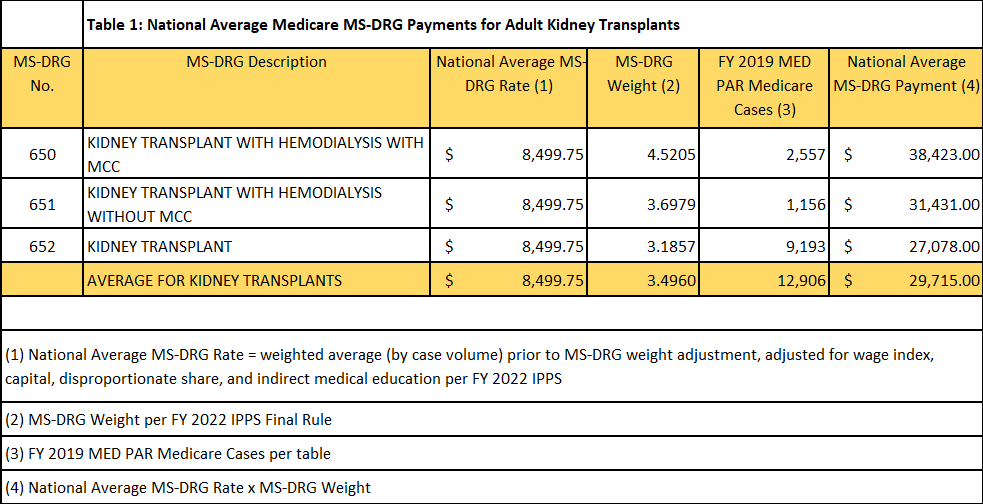Financial Impact of Adult Kidney Transplant MS-DRGs 650, 651 and 652 in U.S. Transplant Hospitals
1VUMC, Nashville, TN, 2Transplant Management Group, San Diego, CA
Meeting: 2022 American Transplant Congress
Abstract number: 591
Keywords: Economics, Kidney transplantation, Medicare
Topic: Administrative » Administrative » 01 - Quality Assurance Process Improvement & Regulatory Issues
Session Information
Session Name: Quality Assurance Process Improvement & Regulatory Issues
Session Type: Rapid Fire Oral Abstract
Date: Tuesday, June 7, 2022
Session Time: 5:30pm-7:00pm
 Presentation Time: 5:50pm-6:00pm
Presentation Time: 5:50pm-6:00pm
Location: Hynes Room 206
*Purpose: The Medicare Hospital Inpatient Prospective Payment System (IPPS) permits each inpatient admission to be categorized into a diagnosis-related group (DRG). DRGs can be further subdivided into Medicare Severity Adjusted DRGs (MS-DRGs) due to the presence of Complication and Comorbidity (CC)/Major Complication and Comorbidity (MCC). The most recent IPPS Final Rule was published September 18, 2020 and implemented October 1, 2020. The Final Rule included new kidney transplant MS-DRGs 650 and 651 to differentiate the MCC status of kidney transplants with hemodialysis. MS-DRG 652 was retained for kidney transplant patients without hemodialysis or CC/MCC. This study compares the financial impact and frequency of kidney transplant MS-DRG rates among adult kidney transplants in the first year of implementation of the new DRG codes.
*Methods: The average MS-DRG rates were calculated for adult transplant hospitals using average IPPS rates and MS-DRG weights based on the FY 2022 IPPS Final Rule. The average IPPS rates for adult transplant hospitals include the wage adjusted base, capital, disproportionate share, and indirect medical education payments. No payment estimate was included for outlier, direct graduate medical education, uncompensated care payment, or organ acquisition payments.
*Results: Table 1 shows the average payment per transplant for each kidney MS-DRG. The differences in National Average MS-DRG payment rates are a result of the MS-DRG weights.
*Conclusions: The National Average MS-DRG Payment for 650 represents a 42% increase over the average payment for MS-DRG 652, and 651 represents a 16% payment increase over MS DRG-652. This additional reimbursement helps to offset the additional costs incurred by the hospital for the provision of hemodialysis services, as well as the higher acuity of certain patient conditions. In order to appropriately document these conditions for justification of the new codes, hospitals should develop a plan to engage physicians through education and conduct per case reviews. Hospitals should begin to routinely monitor the utilization of codes by implementing a process to track coding trends over time. Hospitals, physicians, and coding teams will also need to develop a process that allows for coders to query physicians at the time of billing to resolve any questions regarding documentation. This collaboration can help to ensure that programs are capturing important patient MCCs and accurately accounting for the appropriate reimbursement.
To cite this abstract in AMA style:
Zavala E, Rogers J, Buschmann H, Rath S, Karp S. Financial Impact of Adult Kidney Transplant MS-DRGs 650, 651 and 652 in U.S. Transplant Hospitals [abstract]. Am J Transplant. 2022; 22 (suppl 3). https://atcmeetingabstracts.com/abstract/financial-impact-of-adult-kidney-transplant-ms-drgs-650-651-and-652-in-u-s-transplant-hospitals/. Accessed December 21, 2025.« Back to 2022 American Transplant Congress

